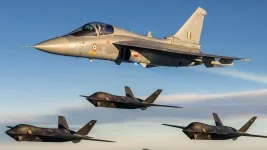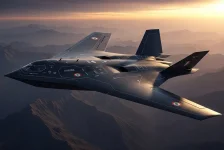- Views: 2K
- Replies: 8
India's defence sector is poised to achieve a major milestone with the development of the Ghatak, a 13-ton Unmanned Combat Aerial Vehicle (UCAV) stealth bomber.
The Ghatak, currently under development, will incorporate cutting-edge Digital Beamforming (DBF) technology, significantly enhancing its radar and communication capabilities and marking a substantial leap forward for India's indigenous defence capabilities.
The Ghatak project, led by India's ADA and DRDO, aims to create a potent stealth platform capable of deep penetration strikes and autonomous operations. While the specific developmental timeline remains under wraps, the inclusion of advanced technologies like DBF demonstrates a commitment to achieving operational superiority.
According to sources, the initial design phase has been completed, and the manufacturing of a full-scale prototype is reportedly underway. The engine development for the project was initially intended to be in collaboration with a foreign partner, but is now progressing indigenously.
DBF is a sophisticated signal processing technique that allows for the electronic steering and shaping of radar and communication beams without the need for physical antenna movement.
Unlike traditional radar systems that rely on mechanically steered antennas, DBF enables real-time, dynamic control over multiple beams simultaneously. This offers significant advantages in terms of speed, accuracy, flexibility, and stealth.
Enhanced Operational Capabilities
The integration of DBF technology into the Ghatak UCAV is expected to provide a wide array of operational benefits:- Enhanced Stealth: DBF allows the Ghatak to focus radar signals precisely, reducing its radar cross-section and making it more difficult for enemy radar systems to detect. This contributes significantly to the UCAV's stealth profile, a crucial factor for operations in contested airspace.
- High-Resolution Imaging: DBF enables the use of advanced Synthetic Aperture Radar (SAR) imaging, allowing the Ghatak to generate high-resolution images of the ground, even in adverse weather conditions or at night. This capability is vital for intelligence gathering, target identification, and battle damage assessment.
- Precise Target Tracking: The UCAV's radar, augmented by DBF, can lock onto and track multiple targets with high accuracy, even at extended ranges. This includes tracking slow-moving or stationary targets, a challenging task for conventional radar systems.
- Electronic Warfare: DBF empowers the Ghatak to conduct sophisticated electronic warfare operations, including jamming enemy radars and communication systems. This capability can provide critical protection for the UCAV and other friendly units.
- Multi-Mode Operation: The DBF system allows the Ghatak to seamlessly switch between different radar modes, such as ground mapping, air-to-air combat, and maritime surveillance, making it a highly versatile asset capable of adapting to various mission profiles.
- Improved Communication: While primarily associated with radar, DBF principles can also be applied to communication systems, potentially allowing for more secure and jam-resistant data links between the UCAV and its ground control station or other assets.




